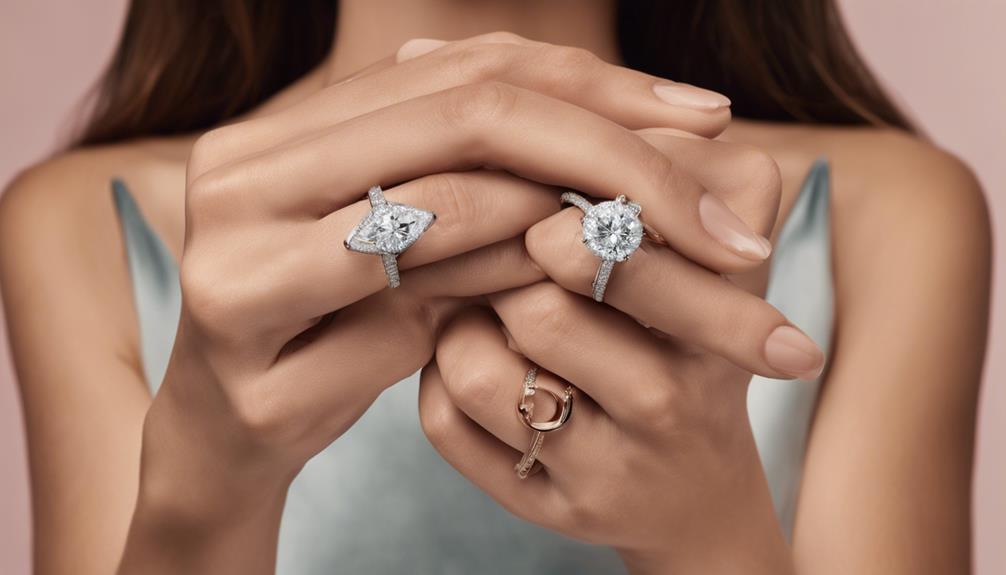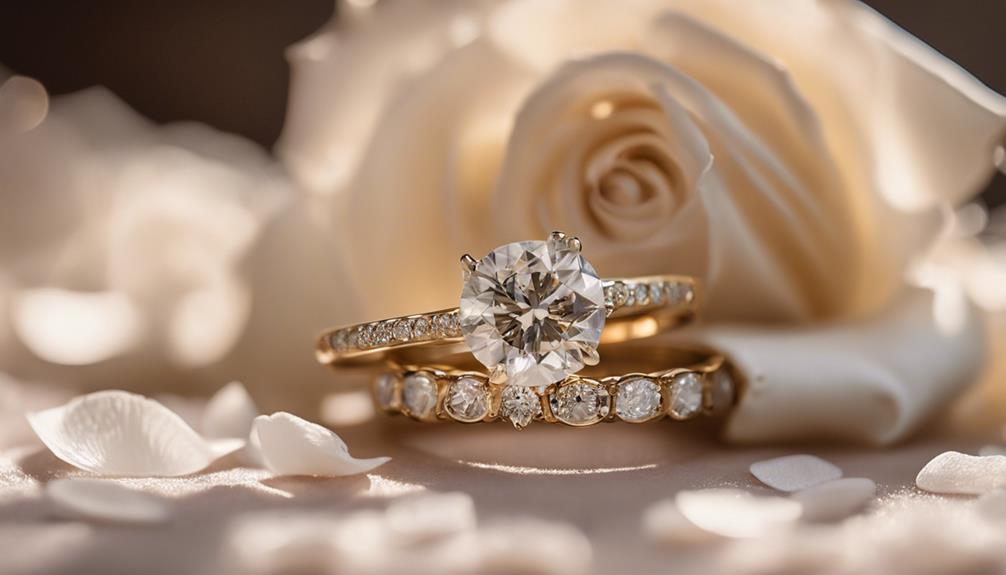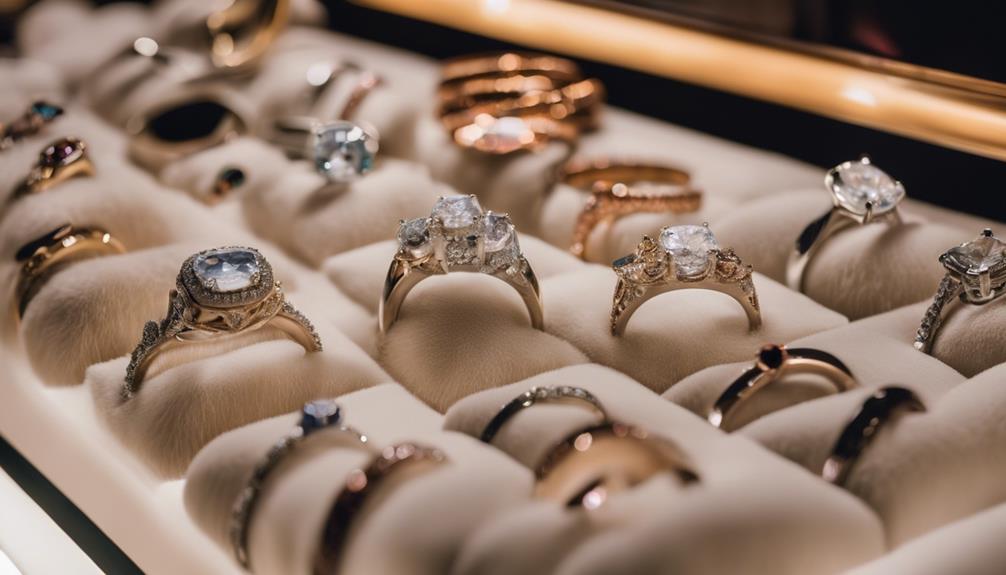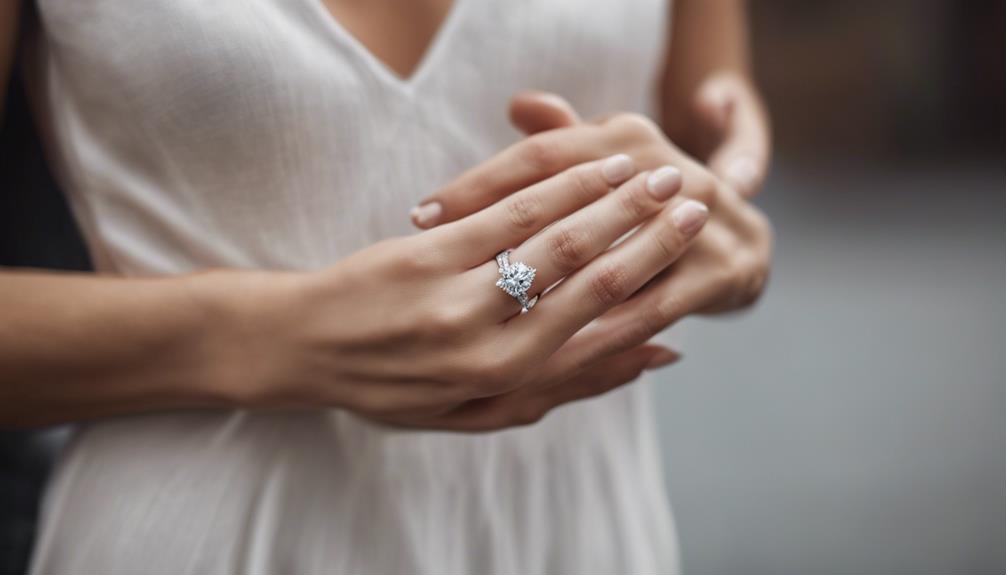Engagement rings and wedding bands aren’t the same thing. The engagement ring, featuring a prominent gemstone, is given during the proposal as a symbol of love and commitment. The wedding band, exchanged during the ceremony, is simpler and symbolizes enduring partnership. Engrained in tradition, the engagement ring typically costs considerably more than the wedding band. You’ll usually wear both on the left hand’s fourth finger, with personal touches tailoring their combined significance. Understanding these distinctions can help you make thoughtful choices about these meaningful symbols of your relationship. There’s much more to uncover about their unique stories and traditions.
Key Differences Explained

When it comes to understanding the differences between engagement rings and wedding bands, it’s important to recognize their distinct roles in a couple’s journey.
The engagement ring is often the first symbol of love you’re introduced to, marking the promise of marriage. It typically features a prominent gemstone, like a diamond, and is designed to capture attention with its elaborate and often expensive design. This ring is usually given during the proposal, a moment filled with anticipation and excitement.
In contrast, the wedding band symbolizes the formal union of two individuals, exchanged during the wedding ceremony. You’ll notice it has a simpler, more minimalist design compared to the engagement ring and is generally less costly, averaging about 10% of the engagement ring’s price.
The wedding band is worn together with the engagement ring on the left hand’s fourth finger, placed closer to the heart to signify the newly formed marital bond.
Understanding these differences between engagement rings and wedding bands helps you appreciate their unique significance. Each plays a crucial role in your relationship, celebrating both the promise of love and the commitment to a shared future.
Symbolic Meanings
Engagement rings and wedding bands not only differ in design and timing but also hold distinct symbolic meanings that enrich a couple’s journey.
When you offer an engagement ring, you’re presenting more than just a piece of jewelry—it’s a profound symbol of love and a promise of a lifelong commitment. Typically, these rings boast a striking design with a prominent gemstone, often a diamond, that captures the excitement and hope of a future together. This ring signifies the beginning of a shared path, marking the intention to marry and solidifying a significant emotional bond.
On the other hand, wedding bands are exchanged during the wedding ceremony and serve as enduring symbols of love and commitment. Their simpler design, often crafted from materials like gold or platinum, represents eternity and the mutual promise of partnership.
Unlike engagement rings, wedding bands are worn by both partners, signifying their union and shared journey through marriage. Together, these bands embody the complete spectrum of a couple’s love story, each holding its unique place in the narrative.
With the engagement ring heralding new beginnings and the wedding band representing lasting unity, they collectively express the depth of your commitment.
Cost Considerations

While both engagement rings and wedding bands are important, their costs can differ greatly due to their distinct features. Engagement rings are generally more expensive, often costing three to five times more than wedding bands. This price difference comes from the engagement ring’s intricate designs and its dominant center stone, usually a diamond. The engagement ring’s cost is influenced heavily by the size and quality of this stone, making it the more extravagant purchase.
On the other hand, wedding bands are simpler and reflect about 10% of the cost of the engagement ring. They often feature plain metal or smaller stones, which results in lower overall costs. The straightforward design of wedding bands also means there’s less financial strain when budgeting for them.
Customization plays an essential role in the cost of engagement rings. Couples looking for unique settings and gemstones might see their costs rise considerably.
In contrast, wedding bands usually offer more standard designs, making customization less of a factor. When planning your budget, consider whether you want to invest more in a standout engagement ring or distribute costs across both rings, depending on your personal preferences and financial capacity.
Wearing Traditions
As you consider the costs of engagement rings and wedding bands, it’s also important to think about how you’ll wear them. Wearing traditions often dictate that the engagement ring sits on the left hand’s fourth finger until the wedding day, when the wedding band is added. Typically, the wedding band is placed underneath the engagement ring, symbolizing its proximity to the heart and the union’s significance.
However, personal preference plays a significant role in these traditions. Some brides opt to wear their rings separately, allowing each piece to shine on its own. Others embrace creative stacks, mixing metals and styles to reflect their unique personalities. There’s no right or wrong way; trends clearly show an increasing acceptance of diverse configurations.
For those who prefer a seamless look, soldering the engagement ring and wedding band together is a popular choice. This approach offers the convenience of wearing them as one unified piece, symbolizing the harmony of marriage.
Ultimately, how you choose to wear your rings should resonate with your individual style and comfort, ensuring that both your engagement ring and wedding band feel like true extensions of your commitment and love.
Choosing the Right Rings

How do you choose the right rings that perfectly symbolize your unique love story? Start by considering the distinction between an engagement ring and a wedding band. Engagement rings often feature a prominent center stone, capturing the promise of marriage, while wedding bands are simpler, symbolizing the union during your ceremony.
When choosing these rings, think about how their design can reflect your relationship’s journey.
Budget plays a significant role. Engagement rings generally cost more due to their intricate designs, often making up about 90% of the total ring cost. Meanwhile, wedding bands are typically around 10% of that price.
Decide how much you want to spend and choose rings that fit within your financial comfort zone.
Consider whether you want matching wedding bands that complement the engagement ring. This cohesive design can beautifully represent your shared commitment and personal style.
Additionally, think about how you’ll wear them. Traditionally, the engagement ring is worn first, with the wedding band added during the ceremony, closer to the heart.
But personal preference matters—whether you stack them or wear just one, choose what feels right for you. Your rings should reflect your love story uniquely and meaningfully.
Conclusion
As you choose your rings, remember they’re more than just jewelry. The engagement ring, with its dazzling gemstone, symbolizes your promise to marry, while the wedding band represents the vows you’ll exchange. Consider their symbolic meanings, cost, and wearing traditions to find what truly resonates with you and your partner. By understanding these distinctions, you can select pieces that beautifully reflect your unique journey, creating cherished symbols of your love and commitment.



